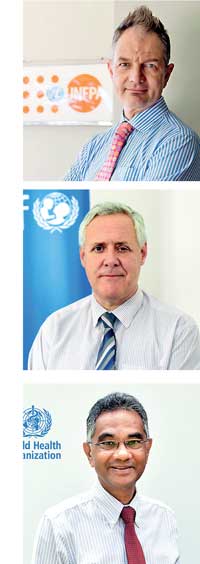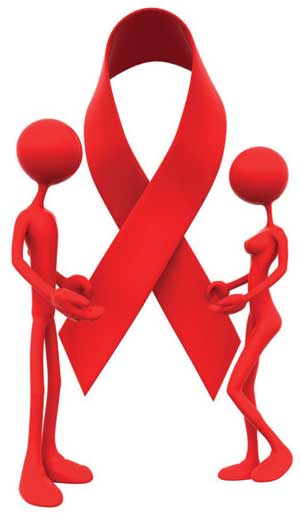Wednesday Dec 11, 2024
Wednesday Dec 11, 2024
Thursday, 1 December 2016 00:00 - - {{hitsCtrl.values.hits}}
By The United Nations Population Fund (UNFPA) Representative Alain Sibenaler, World Health Organization (WHO) Representative Dr. Jacob Kumaresan and The United Nations Children’s Fund (UNICEF) Representative
– Tim Sutton

In 2015, Sri Lanka, along with 192 countries, agreed to achieve the 17 Sustainable Development Goals by 2030. With the underpinning objective of ‘Leaving No One Behind’, Goal 3 ensures healthy lives and promotes well-being for all at all ages. One of the targets leading to achievement of Goal 3 is to end AIDS by 2030. Yet with new HIV infections among adolescents aged 10-19 projected to rise globally if progress stalls, is Sri Lanka on the right path towards ending AIDS?
What has been done, and what more needs to be done? As we mark World AIDS Day on 1 December 2016, the Representatives of UNFPA, WHO, and UNICEF, reflect on Sri Lanka’s work to become an AIDS-free nation.
‘Zero AIDS-related deaths. Zero discrimination. Zero new infections.’ – This is the Triple-Zero mantra preached and practiced around the world with the aim of ending the AIDS epidemic.
But what does the Triple-Zero really mean? Is this an actionable statement that can reap the desired results?
Towards Zero AIDS-related deaths
The first HIV infected person was reported in Sri Lanka in 1987. Since then, approximately 2,500 cases have been reported and 401 AIDS-related deaths have been recorded in Sri Lanka up until
2015, according to the National STD/AIDS Control Programme. Given the collective efforts and strategic investments made by successive Governments, Sri Lanka currently has a low HIV/AIDS prevalence of less than 0.01% of the population.
However, if the virus was to enter the key population networks that engage in behaviours that increase their risk of exposure to HIV, the country situation may dramatically change in relation to HIV prevalence. These population networks include female sex workers, men who have sex with men, ‘beach boys’, and injection drug users.
Therefore, it must be noted that there are serious factors which can trigger a concentrated epidemic in the country, and continuous and collective efforts towards prevention and treatment of HIV/AIDS in Sri Lanka is vital.
One of the first steps in ending AIDS-related deaths in Sri Lanka is to counter the stigma and increase public awareness of the fact that people living with HIV can live a normal and healthy life through early-diagnosis and treatment.
Sri Lanka’s free health service ensures that treatment for those living with HIV is available and accessible to the public. With the right treatment, individuals living with HIV can live a healthy life.
Last year, only one million people were tested for HIV/AIDS in Sri Lanka and it has been estimated that around 4,100 adults living in Sri Lanka are HIV positive, even though only 2,500 cases have been recorded.
Many people are unaware of their HIV status and may unknowingly transmit the virus to others. Self-referral for HIV testing is imperative to know the HIV status and stop the transmission of the disease to ensure the country reaches its target of zero AIDS-related deaths by 2030.

Towards Zero discrimination
Culture and religion can shape values, beliefs, attitudes, and behaviours. In Sri Lanka, as in most societies, among the many socioeconomic factors relating to HIV/AIDS, discrimination is a major concern.
Discrimination prevents open discussion on the subject, impeding awareness and learning.
Discrimination discourages testing, as people are afraid of being stigmatised by society.
Discrimination hinders the path towards achieving an AIDS-free world, country, society, or community.
This is why it is imperative that measures are taken to ensure that discrimination is stopped at all levels of society, as well as within the public and private health systems.
In May 2016, Sri Lanka witnessed a landmark ruling with the Supreme Court prohibiting HIV discrimination in an educational setting. This ruling was prompted by the case of a young boy who was stigmatised by the local community based on the assumption that he was living with HIV, and was therefore prohibited from entering his own school. In response to a fundamental human rights violation petition filed by his mother, Sri Lanka became the first country in South Asia to make a general pronouncement in the highest court, recognising the right to education of all people living with HIV.
This was an important step for the people of Sri Lanka, and the UN Family in Sri Lanka was happy to support this petition, which was led by the Positive Women’s Network.
Yet, there is still much work to be done. Behaviour and attitudinal change can be slow.
Progressive steps in behavioural change communication must be taken to ensure zero discrimination in Sri Lanka. This is one of the major challenges Sri Lanka faces on the path towards ending AIDS by 2030.
Towards Zero new infections
A new UNICEF report released today has highlighted that without a continued focus on prevention and treatment, new HIV infections among adolescents aged 10-19 are projected to rise globally by nearly 60% by 2030.
Therefore, investing in actions that reduce new infections to zero, globally, and here in Sri Lanka, especially among young people, should be a matter of urgency. This is especially important as since 2000, annual AIDS-related deaths globally have declined for all age groups except adolescents, for whom the number has more than doubled, from 18,000 to 41,000.
Research indicates that the main mode of transmission of HIV is unprotected sex between men and women, accounting for 73.7% of reported cases. The second highest mode of transmission is through men who have sex with men, at 20.9%.
Male and female condoms, when used correctly and consistently, provide dual protection against both unintended pregnancy and sexually transmitted infections, including HIV.
The Government has made progressive steps towards ensuring wider reach and accessibility of condoms through a comprehensive distribution network of retail outlets, STD clinics, family planning clinics and through public health midwives.
Sri Lanka’s first Situation Assessment of Condom Programming was carried out in 2015, with the support of UNFPA. This resulted in the National Condom Strategy, which is now being implemented by the Ministry to ensure increased awareness on proper usage of condoms.
In addition, advances in treatment now allow an individual who has been at risk of contracting
HIV, within the previous 72 hours, to follow a 28-day course of medication which significantly reduces their probability of contracting HIV. This treatment is freely available in Sri Lanka, though awareness of its availability is low. It is imperative that greater investment is made to generate awareness of this treatment, which has the capacity to support reductions in the number of cases of new infections, especially among young people.
Another aspect of mitigating new HIV infections is by pre-testing pregnant mothers. While there is no clear research on the number of children living with HIV in Sri Lanka, it is estimated that this number is less than 100 with mother-to-child transmission rates currently standing at approximately 4.4%.
With the collective support of the United Nations Family, the Government has significantly reduced mother-to-child transmission of HIV, partly through the achievement of 72% HIV testing coverage of pregnant mothers. Recently, all pregnant mothers around the island underwent testing, and the Western, Southern and Central Provinces achieved 100% coverage, making it clear that Sri Lanka is near to achieving total elimination of mother-to-child HIV transmission by 2018. To date, only four countries in the world have reached this public health milestone – Cuba, Thailand, Belarus and Armenia.
In ensuring the target of zero new infections is achieved, urgent attention is required towards injection drug users, especially those that share needles, as this group may have limited access to regular healthcare.
The way forward
Sri Lanka has taken bold steps towards achieving the Triple Zero by 2030. Continuing these efforts can ensure that Sri Lanka is on the path towards becoming an AIDS-free nation.
Powerful momentum is building towards fast-tracking this goal by meeting the 90-90-90 target:
90% diagnosis of people living with HIV, 90% of these diagnosed people to receive treatment, and 90% of those undergoing treatment to be virally suppressed by 2020.
Increasing public awareness of the fact that HIV is treatable, reducing the testing gap, ensuring wider use of condoms, encouraging community-based testing, and addressing the stigma that can be associated with HIV, will help reduce the prevalence of HIV from 0.01% to the overall goal of 0% to be achieved by 2030.
The United Nations Family in Sri Lanka is committed to continue our efforts in supporting the
Government of Sri Lanka in ensuring the right measures are taken to consistently monitor the situation and to act effectively in achieving an AIDS-free Sri Lanka.